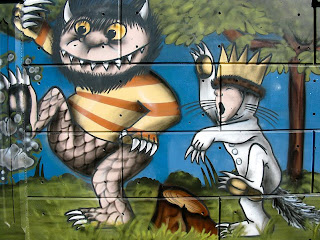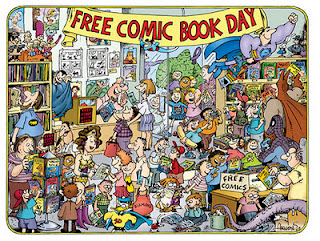Tabletop Role-Playing Gaming with Little Kids (ages 4-9)
 |
| Stealth Fighter's character sheet |
The first thing I did was make rules, and I wanted them very, very simple. Basically, anytime their characters tried to do something difficult, the kids rolled two six-sided dice and summed the results. If it was higher than 6, it was a success, and if it was 6 or lower, it was a setback (not a failure).
I asked them to make characters: What is your character? What weapon does he or she use? What is his or her magic power?
They had no trouble doing this, and the results were delightful. The eldest made "Fireborg," a cyborg man who used a flaming sword and could do an "explosion stomp."
The middle child made "Stealth Fighter," who was half cat and a little bit raccoon. He used spears and could climb on walls as his magic power. He wanted to draw a picture, which you can see in the image. Adorable!
The youngest made "Ninja Blobby," a slimy ninja who threw slime for a weapon and could replicate himself.
My beloved created an elf named "Galadriel" who threw glass balls and could heal people.
That was basically it. We got started.
I made a very basic adventure. The setting was sword-and-sorcery fantasy. Townspeople complained that a monster was stealing their livestock. The characters ventured into the mountains and
had to cross a rickety bridge with flying snakes attacking. Losing rolls are "setbacks" resulting in either some inconvenience (a delay) or actual "harm." Each character had four hit points.
After this first encounter I had them look at their attributes: tough, smart, and magic. They could pick one to get +1 on rolls, another to get +0, and the last would get -1. As you can see from the pictured character sheet, Stealth Fighter had -1 Tough, +1 Smart, and +0 Magic.
Then they encountered a giant locked door. An old man was there and they talked him into giving them the key. This required a roll.
Then they entered the dragon's lair. After a fight they returned to the town, where each got a healing potion as reward.
The whole thing took about 45 minutes, the kids stayed interested throughout, and one asked to play again the next day, this time with a new character, "Glorglius," who was a ghost who could throw electric balls.
Getting kids using their imaginations does not require complex rules. They do it naturally. Just make something simple and go for it.


Comments
I’m curious what prompt you gave them before they “made characters”. Did you constrain it at all, explicitly or implicitly? Did they make the characters, and then you made the adventure.